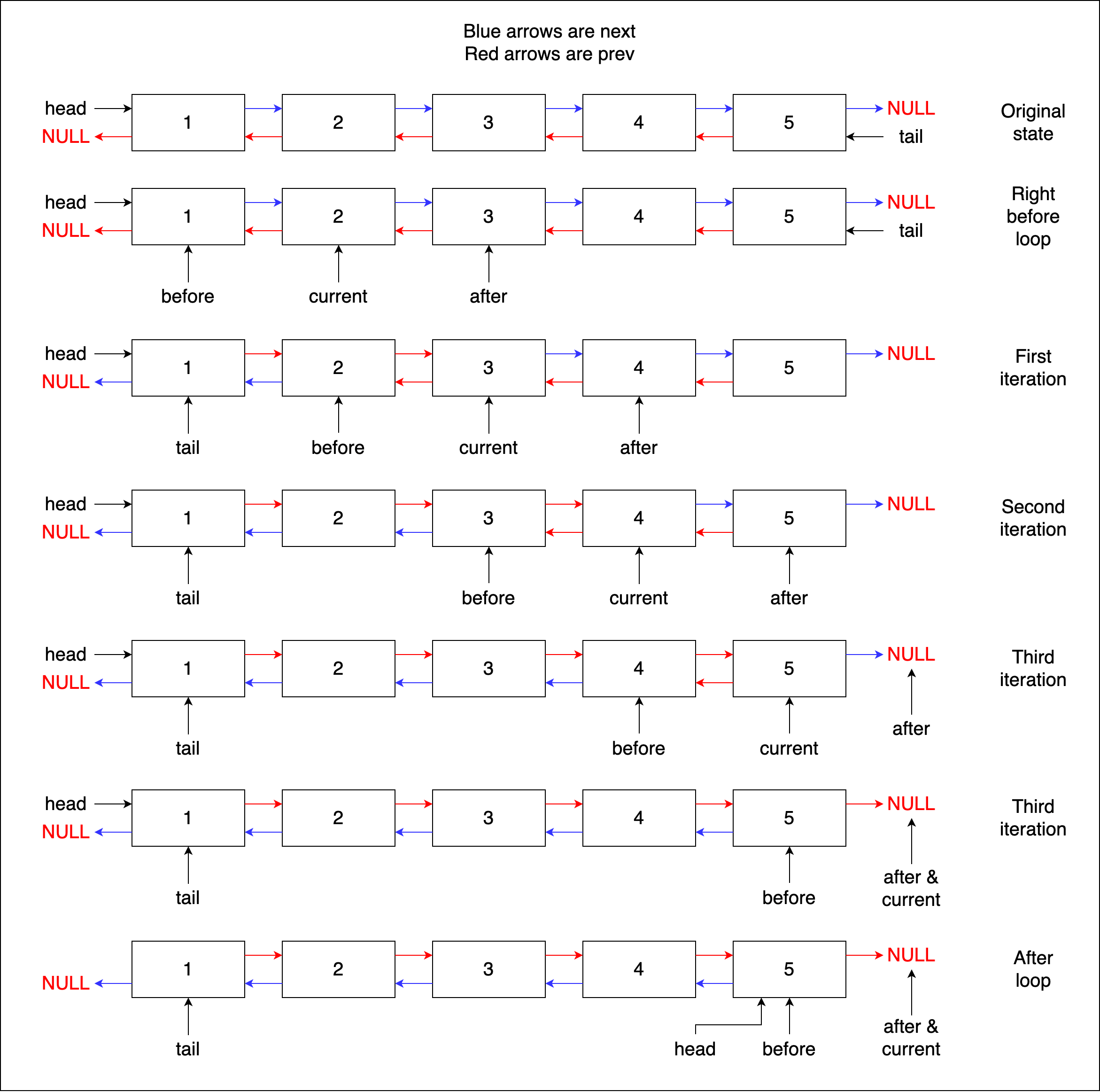How to reverse a doubly linked list in C++
Overview
A doubly linked list (DLL) is a data structure comprising nodes with pointers to the next as well as the previous node. In this Answer, we learn how to reverse a DLL.
Note: For a quick primer on DLLs, we can click here.
We can reverse a DLL in a similar manner to reversing a regular linked list. For this, we need three temporary pointers or nodes, including a tail pointer. Unlike a regular linked list, though, we need to swap around double the number of pointers.
Process
Here are the steps we must follow in our function:
- We check for an empty linked list.
- We introduce three temporary pointers or nodes.
- We introduce a loop that traverses the linked list until the end.
- We convert the first element of the linked list to the
tailright at the start. - We swap connections between three nodes using one of the temporary pointers or nodes.
- We move our three temporary pointers or nodes forward. We repeat this step (3) and the previous one (2) until we reach the end of the linked list.
- We put a condition in place to ensure that, during traversal, none of the temporary pointers is assigned anything other than nodes or
NULL. - We convert the last element, probably pointed towards by one of the temporary pointers or stored in a temporary node, into the
headof the linked list.
A visual representation of the steps above is as follows:
Code
The driver code for our C++ doubly linked list implementation is given below. We coded it using templates. We can use any data type with the implementation, as long as it's consistent, without changing the code itself.
We can see below that we have two linked lists. One of these contains only int values, while the other contains only char values.
Note: If we just want to see the function for a reversal, we can look at the highlighted lines (138–162) in the
linked_list.cppfile.
#ifndef __LIST_CPP#define __LIST_CPP#include "linked_list.h"#include <cstdlib>#include <iostream>using namespace std;// Constructor: Set both head and tail to NULLtemplate <class T>linked_list<T>::linked_list() {head = NULL;tail = NULL;}// Destructor: Memory management (very important)template <class T>linked_list<T>::~linked_list() {for(int i = 0; i < length(); i++) {delete_head();}}// Insert elements to the head (left) of the listtemplate <class T>void linked_list<T>::insert_head(T item) {if(head == NULL) {head = new list_item<T>(item);tail = head;return;}list_item<T> *Node = new list_item<T>(item);head->prev = Node;Node->next = head;head = Node;}// Insert elements to the tail (right) of the listtemplate <class T>void linked_list<T>::insert_tail(T item) {if(tail == NULL) {tail = new list_item<T>(item);head = tail;return;}list_item<T> *Node = new list_item<T>(item);tail->next = Node;Node->prev = tail;tail = Node;}// For checking purposestemplate <class T>list_item<T>* linked_list<T>::get_head() {return head;}// For checking purposestemplate <class T>list_item<T>* linked_list<T>::get_tail() {return tail;}// For the destructortemplate <class T>void linked_list<T>::delete_head() {if(head == NULL) {return;}else if(head->next == NULL) {delete head;head = NULL;tail = NULL;}else {list_item<T> *current = head->next;delete head;head = current;head->prev = NULL;}}// Good to havetemplate <class T>void linked_list<T>::delete_tail() {if(head == NULL) {return;}else if(head->next == NULL) {delete head;head = NULL;tail = NULL;}else {list_item<T> *current = tail->prev;delete tail;tail = current;tail->next = NULL;}}// For demonstration purposestemplate <class T>int linked_list<T>::length() {int count = 0;if(head == NULL) {return count;}else {list_item<T> *current = head;while(current != NULL) {count++;current = current->next;}return count;}}// For demonstration purposestemplate <class T>void linked_list<T>::print() {if(head == NULL) {cout << "empty list";} else {list_item<T> *current = head;while(current != NULL) {if(current->next != NULL) {cout << current->value << " <=> ";} else {cout << current->value;}current = current->next;}}}// The function we want to learn abouttemplate <class T>void linked_list<T>::reverse() {if(head == NULL) {cout << "empty list";} else {list_item<T> *before = head;list_item<T> *current = head->next;list_item<T> *after = head->next->next;while(current != NULL) {if(before->prev == NULL) {before->prev = current;before->next = NULL;tail = before;}current->next = before;current->prev = after;before = current;current = after;if(after != NULL) {after = after->next;}}head = before;}}#endif
Explanation
Here's how the highlighted function in the code above works:
- Lines 140–141: The
ifbranch checks whether the linked list has any values or not. - Lines 143–145: We need three temporary nodes (
list_item), so we make them here. We usebeforeandafterfor bookkeeping and tying up loose ends. Thecurrentpointer is largely responsible for traversing the linked list, and flipping thenextandprevpointers of the nodes. - Lines 147–151: The first
ifin the loop ensures that theheadof the linked list converts into thetail. - Lines 156–158: The second
ifin the loop ensures that whenafteris first assigned toNULLin the second-last iteration, it does not traverse further. Without this handling, the function throws a segmentation fault error. - Line 160: We convert the last node into the
head.
Free Resources
